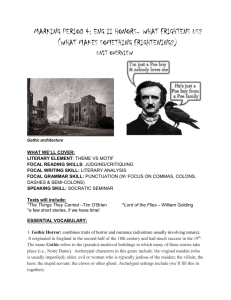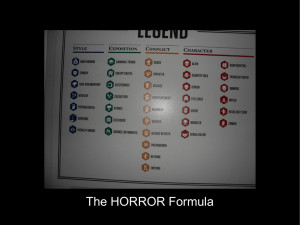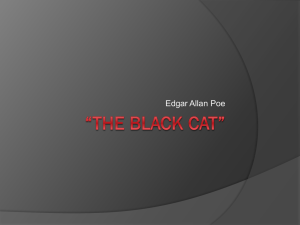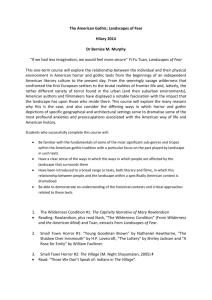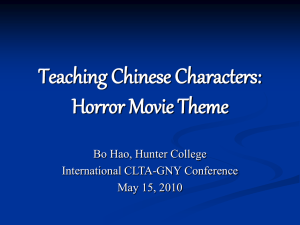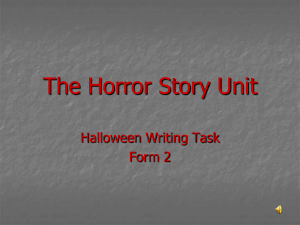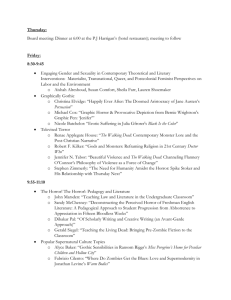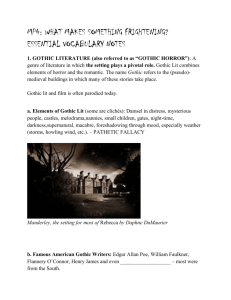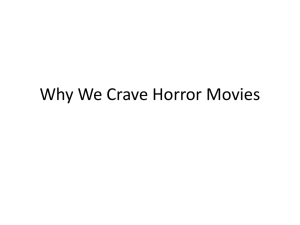Gothic, Horror, and the Mad Scientist
advertisement
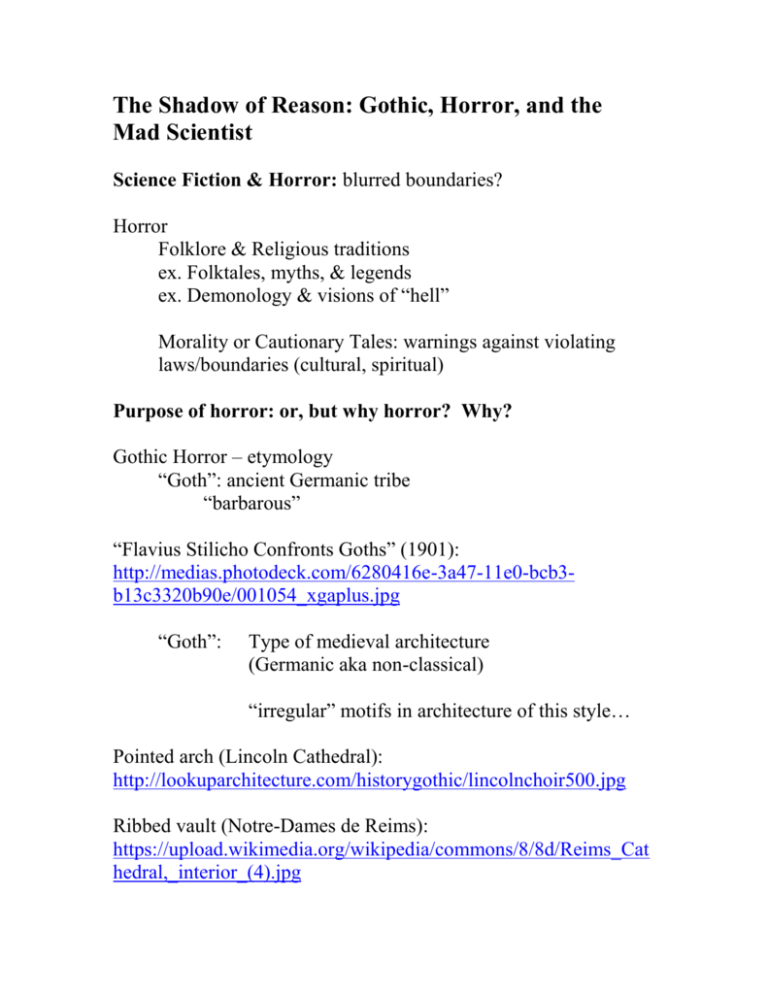
The Shadow of Reason: Gothic, Horror, and the Mad Scientist Science Fiction & Horror: blurred boundaries? Horror Folklore & Religious traditions ex. Folktales, myths, & legends ex. Demonology & visions of “hell” Morality or Cautionary Tales: warnings against violating laws/boundaries (cultural, spiritual) Purpose of horror: or, but why horror? Why? Gothic Horror – etymology “Goth”: ancient Germanic tribe “barbarous” “Flavius Stilicho Confronts Goths” (1901): http://medias.photodeck.com/6280416e-3a47-11e0-bcb3b13c3320b90e/001054_xgaplus.jpg “Goth”: Type of medieval architecture (Germanic aka non-classical) “irregular” motifs in architecture of this style… Pointed arch (Lincoln Cathedral): http://lookuparchitecture.com/historygothic/lincolnchoir500.jpg Ribbed vault (Notre-Dames de Reims): https://upload.wikimedia.org/wikipedia/commons/8/8d/Reims_Cat hedral,_interior_(4).jpg Flying buttress (Sainte-Chapelle de Riom): https://deirdremorgan1.files.wordpress.com/2014/06/flyingbuttresses.jpg Notre-Dame de Reims: http://www.paradoxplace.com/Photo%20Pages/France/Burgundy% 20Champagne/Reims/Reims_Cathedral_West/Images/ReimsWFront-Sept07-DE4330sAR.jpg Notre-Dame de Reims, rose window: https://upload.wikimedia.org/wikipedia/commons/e/ee/Reims_Cat hedrale_Notre_Dame_interior_002.JPG Notre-Dame de Reims, flying buttresses: http://www.unitedeuropeanchristendom.com/UEC_photos_to_web site/uec_fr_reims_notre_dame_cathedral_chevet.jpg Gothic architecture Thinner walls = = larger buildings natural light Commune with God? Reach the heavens? Transcendent? Sublime? Early Gothic Horror Horace Walpole, The Castle of Otranto (1767) - - “A Gothic Story” (2nd ed) “An attempt to blend the two kinds of romance, the ancient and the modern. In the former all was imagination and improbability: in the latter, nature is always intended to be, and sometimes has been, copied with success.” (Walpole 2nd Preface) Ann Radcliffe, The Mysteries of Udolpho (1794) Matthew Lewis, The Monk (1797) Branches of Gothic: Terror (suspense) Horror (grotesque) Characteristics of Gothic Horror 1. Settings evoking Gothic settings (castles, churches) 2. Fear and terror imbued in the physical landscape: images of death and decay 3. Hauntings by the past (including supernatural) 4. Fear of the “dark” ages returning to oppress the more “enlightened” modern era 5. Heightened emotion: melodramatic Frankenstein as Gothic Horror Conception: Fantasmagoriana (1812)– ghost stories June 1816 (Lake Geneva): Lord Byron (age 30) John Polidori (age 22: Byron’s doctor - - “The Vampyre”, 1819) Claire Clairmont (age 18: stepsister to Mary, lover to Byron) Percy Bysshe Shelley (age 23) Mary Shelley (age 18 - - Frankenstein, 1818) Villa Diodati: https://upload.wikimedia.org/wikipedia/commons/6/6c/Villa_dioda ti_2008.07.27_rg_5.JPG Lake Geneva: http://chirkup.me/images/uploaded/00/00/72/7221_original.jpg Frankenstein as Gothic Horror Form: epistolary novel (to accentuate horror) (another famous Gothic horror example: Bram Stoker’s Dracula, 1897) Gothic Horror of settings & events: abandoned & desolate locales Horror (fear and terror) in the natural landscape: external turmoil reflecting internal (psychological) struggle Haunting of the past on the present (Victor & the Creature) Site of Horror: The Present, Internal (Horror in & of the self), Isolation “I busied myself to think of a story, - a story to rival those which had excited us to this task. One which would speak to the mysterious fears of our nature and awaken thrilling horror – one to make the reader dread to look round, to curdle the blood, and quicken the beatings of the heart” (Shelley 7-8). [emphasis added] “mysterious fears of our nature”: #1. Frankenstein Syndrome: fear that science will destroy us #2. Isolation & Alienation: leading to misery and (self) destruction Genre “shadows” in Frankenstein Science Fiction Q: What does it mean to be human? Horror the Monster (Monstrosity) Frankenstein Syndrome “return of the repressed” “Return of the repressed”: Psychoanalysis: Sigmund Freud (1856-1939) Psyche: Id (pleasurable desire: unconscious “pleasure principle”) Ego (mediates “id” & “real world”: conscious “reality principle”) Superego (conscience/ ideal) Repression: society urges us to repress instinctual desire (“id”) BUT repression never complete & the repressed inevitably returns (basic premise of most horror story/film) Pre-Romantics: effects on Gothic Horror in Frankenstein The Sublime Edmund Burke (1729-1797) – fear AND attraction Ideas of the Child & Development John Locke (1632-1704) “tabula rasa” Jean-Jacques Rousseau (1712-1778) “natural” education & corruption of society Nature as “terrific” Primacy of sensory experience Children as innocent & society as corrupting: Monstrous children? Monstrous parents? The Double (Doppelgänger) Walton – Victor – Creature Psychoanalysis: Double as symbol of repressed (double as return of the “repressed”) Carl Jung (1875 - 1961): archetype - “the shadow” Victor first sees the Creature (Victor sees shadow/mirror of himself?) Volume 1, Chapter 5 (Pages 58-59) “I had desired it … rushed downstairs” Frankenstein’s structure as double: Walton – Victor – Creature – Victor – Walton Q (for tutorial): What does the double reveal about the self? Mad Scientist Victor Frankenstein as prototypical “mad scientist”: madness in individual or science? Mad scientist used for satire or horror Jonathan Swift, Gulliver’s Travels (1726) Edgar Allan Poe, “The Facts in the Case of M. Valedmar” (1845) Reflecting on contemporary scientific experimentation & discovery Jonathan Swift, Gulliver’s Travels (1726) Satire Similarities with Science Fiction: Literature of Ideas Portray other worlds but real focus on own society Edgar Allan Poe, “The Facts in the Case of M. Valedmar” (1845) Mesmerism Franz Anton Mesmer (1734 – 1815) “Animal Magnetism” Trance Suggestion Commune with dead? Frankenstein (1910): https://www.youtube.com/watch?v=TcLxsOJK9bs
